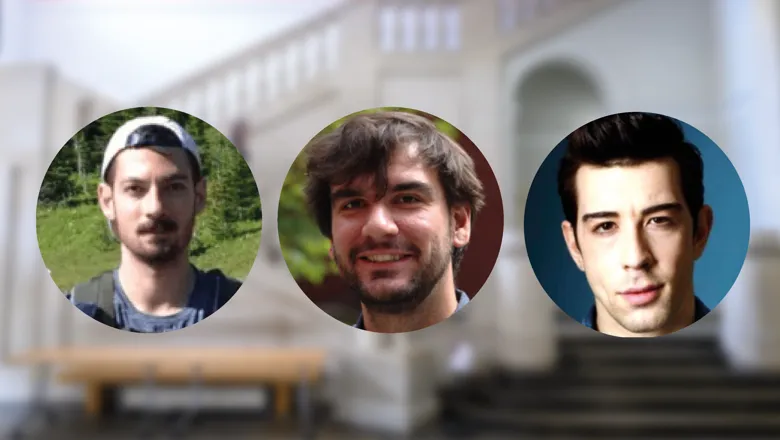By integrating tools first worked with at the birth of computer science and throughout the 1990s, my hope is that this grant will help bring unsupervised machine learning into the 2020s.”
Dr David Watson
22 May 2025
Scientists scoop prestigious New Investigator Awards
The grants will help accelerate the development of trusted AI models, advance our understanding of the mathematics of chaos and accelerate the Net Zero transition.

Three researchers from King’s Faculty of Natural, Mathematical and Engineering Sciences have been awarded esteemed New Investigator Awards to establish research groups tackling issues at the cutting-edge of their fields.
Supported by the Engineering and Physical Sciences Research Council, the highly competitive funding packages will provide over £1.2 million for new algorithms for safe and explainable AI, a universal model for how chaotic systems interact, and a tool to build safe next-generation sustainable technologies.

Dr David Watson, Lecturer in Artificial Intelligence – Probabilistic reasoning with circuits for safe and explainable artificial intelligence
The widespread implementation of AI in all areas of life raises questions about the fairness of the decisions it comes to and how those decisions are reached – particularly in areas like healthcare.
While programs like King’s own Centre for Doctoral Training for Safe & Trusted AI have made significant progress in designing supervised AI models – which automatically learn to predict outcomes in large, labelled training sets – this level of progress has not been replicated for unsupervised AI.
Supervised models need a specific target they need to optimise and aim for, like disease diagnosis). By contrast, unsupervised models detect more general patterns in data that don’t need a defined pre-existing relationship, such as links between clusters of patients who otherwise seem very disparate.
This is particularly useful for areas like healthcare, where scientists may not yet know what to look for in treating or curing a complex disease. By creating a series of algorithms called probabilistic circuits, Dr Watson is hoping to lay the foundation for fair and explainable unsupervised models that respect the privacy of patients in healthcare settings.
By incorporating graphical models and logical circuits, two tools of computer science that help explain the decision a model reaches, these algorithms will eschew the type of labelling around race and socioeconomic status that are known to sometimes bias AI conclusions. They will do this while maintaining an explainable framework, while will contain noise’ within the model to protect individual patient identities.
Dr Watson said, “Irresponsible AI deployment can be dangerous. These black box models can neither explain how they came to specific conclusions, nor justify their latent biases. While a lot of work has been done to help mitigate this in supervised settings, relatively little has been done in unsupervised learning – which could be of an enormous potential benefit.
“By integrating tools first worked with at the birth of computer science and throughout the 1990s, my hope is that this grant will help bring unsupervised machine learning into the 2020s.”

Dr Matteo Tanzi, Lecturer in Disordered Systems and Analysis – Strongly Coupled Maps: Thermodynamic Limits and Rates of Convergence
Chaos theory explores the instability and unpredictability of systems over time. It applies to systems across many fields from – astronomy to epidemiology – where small changes in initial conditions can lead to vastly different outcomes.
The theory first emerged in the 19th century, rooted in the question of whether our solar system is stable over long timescales. Could planets like Earth and Mars one day switch places, driven by the interplay of gravitational forces, for example.
Dr Tanzi explains, “Chaos appears virtually every time that several systems interact. While the solar system is one example, there are many closer to home: the swinging of a pendulum involving multiple parts, or the human brain with its vast number of neurons firing at once.”
“Rigorous mathematics can be used to explain the behaviour of systems composed of multiple interacting components. This is an especially difficult task: when you take into account the passage of time, you are looking at endless potential outcomes. However, some are more likely than others. When dealing with this range of probabilities, it is important to take a probabilistic approach.”
While the work is theoretical in nature, the universal models I study take inspiration from the modelling of real-world systems – for example, epidemics, where complex behaviours like human movement and disease prevalence combine.”
Dr Matteo Tanzi
Within the idea of chaos exist multiple layers of uncertainty – from something as simple as a single neuron to the behaviour of the whole brain. Each of these levels can experience the emergence of something referred to as an ‘equilibrium state’, where behaviour is settled and recognisable but could change at any moment.
“My work aims to rigorously investigate which types of equilibrium state can emerge when many chaotic components interact with one another. I try to build universal models that identify how the features of a single component can impact the behaviour of the system as a whole. While the work is theoretical in nature, the universal models I study take inspiration from the modelling of real-world systems – for example, epidemics, where complex behaviours like human movement and disease prevalence combine.”
By anticipating how multiple layers of uncertainty within a single system interact and propagate chaos, Dr Tanzi hopes to use mathematical analysis to identify where to intervene to stir a system's behaviour away from potentially harmful behaviour.

Dr Christos Skamniotis, Lecturer in Engineering – Discrete Dislocation modelling of low cycle thermomechanical fatigue in Nickel alloys
To make the Net Zero transition a fundamental rethink of our transport and energy infrastructure is needed, as well as the materials we use to build them. But as unprecedented new technologies like hydrogen powered planes and nuclear fusion reactors emerge, how can we make sure they’re safe if there is no comparable tech we can look at to see how and when they fail?
This is particularly the case for engines and reactors which experience regular start-stop cycles, initiated by the turn of a key or the changing temperature experienced by atoms in a fusion reactor. These result in temperature fluctuations which can cause deformations and cracks in metal over time, potentially leading to catastrophic failure.
Dr Skamniotis’ work will create a new approach to computationally model strong nickel superalloys being used in next-gen transport and energy technologies to understand, predict and mitigate the chances of failure in the start-stop cycle of daily operations.
By digging into what this thermomechanical fatigue can do to metals at their most micro level, and then modelling how those potential cracks might propagate and cause failure, our code will empower engineers to deliver transformative change for the UK’s transport and energy sectors.”
Dr Christos Skamniotis
He explains, “Nuclear fusion reactors experience temperatures of up to 100 million degrees and it only takes one crack in its housing for a potential meltdown. Temperature fluctuations, whether fast or slow, experienced by metals in an engine, turbine or any other device over time can cause deformations – but we are yet to achieve a true understanding of what new technologies might do to metals. This is a major barrier in their uptake and the Net Zero transition.
“By digging into what this thermomechanical fatigue can do to metals at their most micro level, and then modelling how those potential cracks might propagate and cause failure, our code will empower engineers to deliver transformative change for the UK’s transport and energy sectors.”
The global team includes partners at Imperial College, University of Leicester, University of Twente, Rolls-Royce and the UK Atomic Energy Authority, with applications in new jet engines, nuclear fusion/fission reactors, hydrogen fuelled transport and hypersonic technologies.



